Occupants’ Decision-Making of Their Energy Behaviours in Office Environments: A Case of New Zealand
Abstract
:1. Introduction
- RQ1. What do occupants perceive about their indoor environment and the availability of control?
- RQ2. What are the specific social-psychological impacts on occupant behaviours?
- RQ3. What triggers the specific occupant behaviours?
2. Materials and Methods
2.1. Survey Approach
2.2. Characteristics of the Buildings
2.3. Demographic Profile of Participants
2.4. Variables of the Study
- Indoor temperature: Too cold, cold, about right, hot, too hot
- Indoor air quality: Too stuffy, stuffy, about right, draughty, too draughty
- Natural/artificial light: Too dark, dark, about right, bright, too bright
- Inside/outside noise: Too quiet, quiet, about right, noisy, too noisy
2.5. Data Analysis
2.5.1. Reliability of the Survey Data
2.5.2. Evaluation of Multi-Domain Aspects
2.5.3. Decision Tree Analysis
2.5.4. Scope of Analysis
3. Results and Discussion
3.1. Perceived Comfort in IEQ
3.2. Availability of User Control
3.3. Social-Psychological Factors
3.4. Decision Tree Analysis
3.5. Excluded Behaviours from the Analysis
4. Conclusions
Author Contributions
Funding
Institutional Review Board Statement
Informed Consent Statement
Data Availability Statement
Acknowledgments
Conflicts of Interest
Appendix A
| Source | Influential/Driving Factors | Type of Building | |||
|---|---|---|---|---|---|
| Office | Residential | Other | |||
| [33] | Deme Belafi et al. (2018) | Outdoor temperatures | School | ||
| Indoor air quality | |||||
| [59] | Park and Choi (2019) | Indoor and outdoor air temperature | ✓ | ||
| Indoor relative humidity | |||||
| CO2 concentration | |||||
| Season | |||||
| Occupancy | |||||
| Time of the day | |||||
| Source | Influential/Driving Factors | Type of Building | |||
|---|---|---|---|---|---|
| Office | Residential | Other | |||
| [61] | Bavaresco and Ghisi (2018) | Solar radiation | ✓ | ||
| Building orientation | |||||
| [62] | Gunay et al. (2017) | Workplane illuminance | ✓ | ||
| Glare sensitivity | |||||
| Outdoor view | |||||
| Source | Influential/Driving Factors | Type of Building | |||
|---|---|---|---|---|---|
| Office | Residential | Other | |||
| [63] | Park et al. (2019) | Occupancy | ✓ | ||
| Workplace illuminance | |||||
| Lighting state | |||||
| [64] | Norouziasl et al. (2019) | Occupancy | ✓ | ||
| No. of occupants | |||||
| Source | Plugins | Influential/Driving Factors | Type of Building | |||||
|---|---|---|---|---|---|---|---|---|
| Fans | Thermostat | Computers | Office | Residential | Other | |||
| [66] | He at al. (2019) | ✓ | Indoor and outdoor temperature | |||||
| [67] | Acker et al. (2012) | ✓ | ✓ | Behavioural intervention | ✓ | |||
| [68] | Park and Nagy (2020) | ✓ | Indoor air temperature | ✓ | ||||
| Occupancy | ||||||||
| Thermal vote | ||||||||
| [69] | Sintov et al. (2019) | ✓ | Gender | ✓ | ||||
| [70] | Zhao et al. (2014) | ✓ | ✓ | ✓ | Occupancy schedules | ✓ | ||
| [71] | Kwong et al. (2014) | ✓ | Working hours | ✓ | ||||
| Source | Influential/Driving Factors | Type of Building | |||
|---|---|---|---|---|---|
| Office | Residential | Other | |||
| [73] | Rupp et al. (2021) | Indoor and outdoor air temperature | ✓ | ||
| Thermal sensation | |||||
| Clothing insulation | |||||
| Source | Influential/Driving Factors | Type of Building | |||
|---|---|---|---|---|---|
| Office | Residential | Other | |||
| [75] | von Grabe (2020) | Thermal perception | ✓ | ||
| [76] | Chen and Chang (2012) | Indoor temperature | ✓ | ||
| Local climate | |||||
| [77] | Mustapa et al. (2016) | Outdoor air temperature | University | ||
| [78] | Schiavon and Lee (2013) | Outdoor air temperatures | ✓ | ||
| Relative humidity | |||||
| Indoor operative temperature | |||||
| Air velocity | |||||
| Metabolic activity | |||||
References
- Gaetani, I.; Hoes, P.-J.; Hensen, J.L.M. A stepwise approach for assessing the appropriate occupant behaviour modelling in building performance simulation. J. Build. Perform. Simul. 2020, 13, 362–377. [Google Scholar] [CrossRef]
- Santangelo, A.; Yan, D.; Feng, X.; Tondelli, S. Renovation strategies for the Italian public housing stock: Applying building energy simulation and occupant behaviour modelling to support decision-making process. Energy Build. 2018, 167, 269–280. [Google Scholar] [CrossRef]
- Yoshino, H.; Hong, T.; Nord, N. IEA EBC annex 53: Total energy use in buildings–Analysis and evaluation methods. Energy Build. 2017, 152, 124–136. [Google Scholar] [CrossRef] [Green Version]
- Jia, M.; Srinivasan, R.S.; Ries, R.; Weyer, N.; Bharathy, G. A systematic development and validation approach to a novel agent-based modeling of occupant behaviors in commercial buildings. Energy Build. 2019, 199, 352–367. [Google Scholar] [CrossRef]
- Lee, Y.S.; Malkawi, A.M. Simulating multiple occupant behaviors in buildings: An agent-based modelling approach. Energy Build. 2014, 69, 407–416. [Google Scholar] [CrossRef]
- Yan, D.; Hong, T.; Dong, B.; Mahdavi, A.; D’Oca, S.; Gaetani, I.; Feng, X. IEA EBC Annex 66: Definition and simulation of occupant behavior in buildings. Energy Build. 2017, 156, 258–270. [Google Scholar] [CrossRef] [Green Version]
- Carlucci, S.; De Simone, M.; Firth, S.K.; Kjærgaard, M.B.; Markovic, R.; Rahaman, M.S.; van Treeck, C. Modeling occupant behavior in buildings. Build. Environ. 2020, 174, 106768. [Google Scholar] [CrossRef]
- Yan, D.; O’Brien, W.; Hong, T.; Feng, X.; Burak Gunay, H.; Tahmasebi, F.; Mahdavi, A. Occupant behavior modeling for building performance simulation: Current state and future challenges. Energy Build. 2015, 107, 264–278. [Google Scholar] [CrossRef] [Green Version]
- Chen, J.; Taylor, J.E.; Wei, H.-H. Modeling building occupant network energy consumption decision-making: The interplay between network structure and conservation. Energy Build. 2012, 47, 515–524. [Google Scholar] [CrossRef]
- Franceschini, P.B.; Neves, L.O. A critical review on occupant behaviour modelling for building performance simulation of naturally ventilated school buildings and potential changes due to the COVID-19 pandemic. Energy Build. 2022, 258, 111831. [Google Scholar] [CrossRef]
- Hong, T.; Yan, D.; D’Oca, S.; Chen, C.F. Ten questions concerning occupant behavior in buildings: The big picture. Build. Environ. 2017, 114, 518–530. [Google Scholar] [CrossRef] [Green Version]
- Malik, J.; Mahdavi, A.; Azar, E.; Chandra Putra, H.; Berger, C.; Andrews, C.; Hong, T. Ten questions concerning agent-based modeling of occupant behavior for energy and environmental performance of buildings. Build. Environ. 2022, 217, 109016. [Google Scholar] [CrossRef]
- O’Brien, W.; Gaetani, I.; Carlucci, S.; Hoes, P.J.; Hensen, J.L.M. On occupant-centric building performance metrics. Build. Environ. 2017, 122, 373–385. [Google Scholar] [CrossRef]
- Amasyali, K.; El-Gohary, N.M. A review of data-driven building energy consumption prediction studies. Renew. Sustain. Energy Rev. 2018, 81, 1192–1205. [Google Scholar] [CrossRef]
- Dong, B.; Yan, D.; Li, Z.; Jin, Y.; Feng, X.; Fontenot, H. Modeling occupancy and behavior for better building design and operation—A critical review. Build. Simul. 2018, 11, 899–921. [Google Scholar] [CrossRef]
- Jia, M.; Srinivasan, R.S.; Raheem, A.A. From occupancy to occupant behavior: An analytical survey of data acquisition technologies, modeling methodologies and simulation coupling mechanisms for building energy efficiency. Renew. Sustain. Energy Rev. 2017, 68, 525–540. [Google Scholar] [CrossRef]
- Hong, T.; D’Oca, S.; Turner, W.J.N.; Taylor-Lange, S.C. An ontology to represent energy-related occupant behavior in buildings. Part I: Introduction to the DNAs framework. Build. Environ. 2015, 92, 764–777. [Google Scholar] [CrossRef] [Green Version]
- Hong, T.; D’Oca, S.; Taylor-Lange, S.C.; Turner, W.J.N.; Chen, Y.; Corgnati, S.P. An ontology to represent energy-related occupant behavior in buildings. Part II: Implementation of the DNAS framework using an XML schema. Build. Environ. 2015, 94, 196–205. [Google Scholar] [CrossRef] [Green Version]
- Cheung, T.; Graham, L.T.; Schiavon, S. Impacts of life satisfaction, job satisfaction and the Big Five personality traits on satisfaction with the indoor environment. Build. Environ. 2022, 212, 108783. [Google Scholar] [CrossRef]
- De Vecchi, R.; Candido, C.; de Dear, R.; Lamberts, R. Thermal comfort in office buildings: Findings from a field study in mixed-mode and fully-air conditioning environments under humid subtropical conditions. Build. Environ. 2017, 123, 672–683. [Google Scholar] [CrossRef]
- Yang, R.; Wang, L. Development of multi-agent system for building energy and comfort management based on occupant behaviors. Energy Build. 2013, 56, 1–7. [Google Scholar] [CrossRef]
- Heydarian, A.; McIlvennie, C.; Arpan, L.; Yousefi, S.; Syndicus, M.; Schweiker, M.; Mahdavi, A. What drives our behaviors in buildings? A review on occupant interactions with building systems from the lens of behavioral theories. Build. Environ. 2020, 179, 106928. [Google Scholar] [CrossRef]
- Yun, G.Y.; Steemers, K.; Baker, N. Natural ventilation in practice: Linking facade design, thermal performance, occupant perception and control. Build. Res. Inf. 2018, 36, 608–624. [Google Scholar] [CrossRef]
- Schakib-Ekbatan, K.; Çakici, F.Z.; Schweiker, M.; Wagner, A. Does the occupant behavior match the energy concept of the building? Analysis of a German naturally ventilated office building. Build. Environ. 2015, 84, 142–150. [Google Scholar] [CrossRef]
- Schweiker, M.; Carlucci, S.; Andersen, R.K.; Dong, B.; O’Brien, W. Occupancy and Occupants’ Actions. In Exploring Occupant Behavior in Buildings: Methods and Challenges; Wagner, A., O’Brien, W., Dong, B., Eds.; Springer Cham: New York, NY, USA, 2018; pp. 7–38. [Google Scholar]
- Day, J.K.; McIlvennie, C.; Brackley, C.; Tarantini, M.; Piselli, C.; Hahn, J.; Pisello, A.L. A review of select human-building interfaces and their relationship to human behavior, energy use and occupant comfort. Build. Environ. 2020, 178, 106920. [Google Scholar] [CrossRef]
- Weerasinghe, A.S.; Rasheed, E.O.; Rotimi, J.O.B. A facilities management approach to rationalising occupants’ energy behaviours. Facilities 2022, 40, 774–792. [Google Scholar] [CrossRef]
- Li, D.; Xu, X.; Chen, C.-f.; Menassa, C. Understanding energy-saving behaviors in the American workplace: A unified theory of motivation, opportunity, and ability. Energy Res. Soc. Sci. 2019, 51, 198–209. [Google Scholar] [CrossRef]
- Vellei, M.; Natarajan, S.; Biri, B.; Padget, J.; Walker, I. The effect of real-time context-aware feedback on occupants’ heating behaviour and thermal adaptation. Energy Build. 2016, 123, 179–191. [Google Scholar] [CrossRef] [Green Version]
- Ozcelik, G.; Becerik-Gerber, B.; Chugh, R. Understanding human-building interactions under multimodal discomfort. Build. Environ. 2019, 151, 280–290. [Google Scholar] [CrossRef]
- Bavaresco, M.V.; Ghisi, E.; D’Oca, S.; Pisello, A.L. Triggering occupant behaviour for energy sustainability: Exploring subjective and comfort-related drivers in Brazilian offices. Energy Res. Soc. Sci. 2021, 74, 101959. [Google Scholar] [CrossRef]
- Bavaresco, M.V.; D’Oca, S.; Ghisi, E.; Pisello, A.L. Assessing underlying effects on the choices of adaptive behaviours in offices through an interdisciplinary framework. Build. Environ. 2020, 181, 107086. [Google Scholar] [CrossRef]
- Deme Belafi, Z.; Naspi, F.; Arnesano, M.; Reith, A.; Revel, G.M. Investigation on window opening and closing behavior in schools through measurements and surveys: A case study in Budapest. Build. Environ. 2018, 143, 523–531. [Google Scholar] [CrossRef]
- Chen, C.f.; Xu, X.; Day, J.K. Thermal comfort or money saving? Exploring intentions to conserve energy among low-income households in the United States. Energy Res. Soc. Sci. 2017, 26, 61–71. [Google Scholar] [CrossRef]
- Gao, L.; Wang, S.; Li, J.; Li, H. Application of the extended theory of planned behavior to understand individual’s energy saving behavior in workplaces. Resour. Conserv. Recycl. 2017, 127, 107–113. [Google Scholar] [CrossRef]
- Obaidellah, U.H.; Danaee, M.; Mamun, M.A.A.; Hasanuzzaman, M.; Rahim, N.A. An application of TPB constructs on energy-saving behavioural intention among university office building occupants: A pilot study in Malaysian tropical climate. J. Hous. Built Environ. 2019, 34, 533–569. [Google Scholar] [CrossRef]
- Fu, W.; Zhou, Y.; Li, L.; Yang, R. Understanding household electricity-saving behavior: Exploring the effects of perception and cognition factors. Sustain. Prod. Consum. 2021, 28, 116–128. [Google Scholar] [CrossRef]
- Rissetto, R.; Rambow, R.; Schweiker, M. Assessing comfort in the workplace: A unified theory of behavioral and thermal expectations. Build. Environ. 2022, 216, 109015. [Google Scholar] [CrossRef]
- Cornelius, M.; Armel, K.C.; Hoffman, K.; Allen, L.; Bryson, S.W.; Desai, M.; Robinson, T.N. Increasing energy- and greenhouse gas-saving behaviors among adolescents: A school-based cluster-randomised controlled trial. Energy Effic. 2014, 7, 217–242. [Google Scholar] [CrossRef]
- Deme Bélafi, Z.; Reith, A. Interdisciplinary survey to investigate energy-related occupant behavior in offices-The Hungarian case. Pollack Period. 2018, 13, 41–52. [Google Scholar] [CrossRef]
- Li, D.; Menassa, C.C.; Karatas, A. Energy use behaviors in buildings: Towards an integrated conceptual framework. Energy Res. Soc. Sci. 2017, 23, 97–112. [Google Scholar] [CrossRef] [Green Version]
- Xu, X.; Maki, A.; Chen, C.-f.; Dong, B.; Day, J.K. Investigating willingness to save energy and communication about energy use in the American workplace with the attitude-behavior-context model. Energy Res. Soc. Sci. 2017, 32, 13–22. [Google Scholar] [CrossRef]
- Mills, A.J.; Durepos, G.; Wiebe, E. Encyclopedia of Case Study Research; SAGE Publications Inc.: Thousand Oaks, CA, USA, 2010; pp. 124–126. [Google Scholar]
- Du, J.; Pan, W. Examining energy saving behaviors in student dormitories using an expanded theory of planned behavior. Habitat Int. 2021, 107, 102308. [Google Scholar] [CrossRef]
- Fabi, V.; Andersen, R.V.; Corgnati, S.; Olesen, B.W. Occupants’ window opening behaviour: A literature review of factors influencing occupant behaviour and models. Build. Environ. 2012, 58, 188–198. [Google Scholar] [CrossRef]
- O’Brien, W.; Gunay, H.B. The contextual factors contributing to occupants’ adaptive comfort behaviors in offices–A review and proposed modeling framework. Build. Environ. 2014, 77, 77–87. [Google Scholar] [CrossRef]
- D’Oca, S.; Chen, C.F.; Hong, T.; Belafi, Z. Synthesising building physics with social psychology: An interdisciplinary framework for context and occupant behavior in office buildings. Energy Res. Soc. Sci. 2017, 34, 240–251. [Google Scholar] [CrossRef] [Green Version]
- Asadi, I.; Mahyuddin, N.; Shafigh, P. A review on indoor environmental quality (IEQ) and energy consumption in building based on occupant behavior. Facilities 2017, 35, 684–695. [Google Scholar] [CrossRef]
- Cronbach, L.J. Coefficient alpha and the internal structure of tests. Psychometrika 1951, 16, 297–334. [Google Scholar] [CrossRef] [Green Version]
- Boone, H.N.; Boone, D.A. Analysing Likert Data. J. Ext. 2012, 50, 1–5. [Google Scholar]
- Lu, H.; Ma, X. Hybrid decision tree-based machine learning models for short-term water quality prediction. Chemosphere 2020, 249, 126169. [Google Scholar] [CrossRef]
- Rizvi, S.; Rienties, B.; Khoja, S.A. The role of demographics in online learning; A decision tree based approach. Comput. Educ. 2019, 137, 32–47. [Google Scholar] [CrossRef]
- Han, J.; Kamber, M.; Pei, J. Classification: Basic Concepts. In Data Mining, 3rd ed.; Morgan Kaufmann: Waltham, MA, USA, 2012; pp. 327–391. [Google Scholar]
- Ryu, S.H.; Moon, H.J. Development of an occupancy prediction model using indoor environmental data based on machine learning techniques. Build. Environ. 2016, 107, 1–9. [Google Scholar] [CrossRef]
- Farrelly, C.M. Deep vs. Diverse Architectures for Classification Problems. arXiv 2017. [Google Scholar] [CrossRef]
- Shao, Y.; Lunetta, R.S. Comparison of support vector machine, neural network, and CART algorithms for the land-cover classification using limited training data points. ISPRS J. Photogramm. Remote Sens. 2012, 70, 78–87. [Google Scholar] [CrossRef]
- Kim, Y.S. Comparison of the decision tree, artificial neural network, and linear regression methods based on the number and types of independent variables and sample size. Expert Syst. Appl. 2008, 34, 1227–1234. [Google Scholar] [CrossRef]
- Khalifa, R.M.; Yacout, S.; Bassetto, S. Developing machine-learning regression model with Logical Analysis of Data (LAD). Comput. Ind. Eng. 2021, 151, 106947. [Google Scholar] [CrossRef]
- Park, J.; Choi, C.S. Modeling occupant behavior of the manual control of windows in residential buildings. Indoor Air 2019, 29, 242–251. [Google Scholar] [CrossRef]
- Zhang, Y.; Wang, Z.; Zhou, G. Antecedents of employee electricity saving behavior in organisations: An empirical study based on norm activation model. Energy Policy 2013, 62, 1120–1127. [Google Scholar] [CrossRef]
- Bavaresco, M.V.; Ghisi, E. Influence of user interaction with internal blinds on the energy efficiency of office buildings. Energy Build. 2018, 166, 538–549. [Google Scholar] [CrossRef]
- Gunay, H.B.; O’Brien, W.; Beausoleil-Morrison, I.; Gilani, S. Development and implementation of an adaptive lighting and blinds control algorithm. Build. Environ. 2017, 113, 185–199. [Google Scholar] [CrossRef]
- Park, J.Y.; Dougherty, T.; Fritz, H.; Nagy, Z. LightLearn: An adaptive and occupant centered controller for lighting based on reinforcement learning. Build. Environ. 2019, 147, 397–414. [Google Scholar] [CrossRef]
- Norouziasl, S.; Jafari, A.; Wang, C. Analysis of lighting occupancy sensor installation in building renovation using agent-based modeling of occupant behavior. In Proceedings of the ASCE International Conference on Computing in Civil Engineering 2019, Atlanta, GA, USA, 17–19 June 2019. [Google Scholar]
- Yao, J. Determining the energy performance of manually controlled solar shades: A stochastic model based co-simulation analysis. Appl. Energy 2014, 127, 64–80. [Google Scholar] [CrossRef]
- He, Y.; Chen, W.; Wang, Z.; Zhang, H. Review of fan-use rates in field studies and their effects on thermal comfort, energy conservation, and human productivity. Energy Build. 2019, 194, 140–162. [Google Scholar] [CrossRef] [Green Version]
- Acker, B.; Duarte, C.; Van Den Wymelenberg, K. Office space plug load profiles and energy saving interventions. In Proceedings of the ACEEE 2012 Summer Study on Energy Efficiency in Buildings-Fueling our future with efficiency, Pacific Grove, CA, USA, 12–17 August 2012. [Google Scholar]
- Park, J.Y.; Nagy, Z. HVACLearn: A reinforcement learning based occupant-centric control for thermostat set-points. In Proceedings of the 11th ACM International Conference on Future Energy Systems, Virtual, 22–26 June 2020. [Google Scholar]
- Sintov, N.D.; White, L.V.; Walpole, H. Thermostat wars? The roles of gender and thermal comfort negotiations in household energy use behavior. PLoS ONE 2019, 14, e0224198. [Google Scholar] [CrossRef] [Green Version]
- Zhao, J.; Lasternas, B.; Lam, K.P.; Yun, R.; Loftness, V. Occupant behavior and schedule modeling for building energy simulation through office appliance power consumption data mining. Energy Build. 2014, 82, 341–355. [Google Scholar] [CrossRef]
- Kwong, Q.J.; Goh, S.H.; Adam, N.M.; Raghavan, V.R. A study on energy efficiency improvement opportunities for plug loads in buildings in the equatorial region. Energy Procedia 2014, 56, 621–633. [Google Scholar] [CrossRef] [Green Version]
- Xie, C.; Ding, H.; Zhang, H.; Yuan, J.; Su, S.; Tang, M. Exploring the psychological mechanism underlying the relationship between organisational interventions and employees’ energy-saving behaviors. Energy Policy 2021, 156, 112411. [Google Scholar] [CrossRef]
- Rupp, R.F.; Andersen, R.K.; Toftum, J.; Ghisi, E. Occupant behaviour in mixed-mode office buildings in a subtropical climate: Beyond typical models of adaptive actions. Build. Environ. 2021, 190, 107541. [Google Scholar] [CrossRef]
- Weerasinghe, A.S.; Rasheed, E.O.; Rotimi, J.O.B. Environmental and socio-psychological drivers of building users’ behaviours: A case study of tertiary institutional offices in Auckland. J. Facil. Manag. 2022. ahead-of-print. [Google Scholar] [CrossRef]
- von Grabe, J. Using the Instance-Based Learning Paradigm to Model Energy-Relevant Occupant Behaviors in Buildings. Cogn. Comput. 2020, 12, 71–99. [Google Scholar] [CrossRef]
- Chen, A.; Chang, W. Human health and thermal comfort of office workers in Singapore. Build. Environ. 2012, 58, 172–178. [Google Scholar] [CrossRef]
- Mustapa, M.S.; Zaki, S.A.; Rijal, H.B.; Hagishima, A.; Sukri, M.; Ali, M. Thermal comfort and occupant adaptive behaviour in Japanese university buildings with free running and cooling mode offices during summer. Build. Environ. 2016, 105, 332–342. [Google Scholar] [CrossRef]
- Schiavon, S.; Lee, K.H. Dynamic predictive clothing insulation models based on outdoor air and indoor operative temperatures. Build. Environ. 2013, 59, 250–260. [Google Scholar] [CrossRef] [Green Version]
- Ahn, K.-U.; Kim, D.-W.; Park, C.-S.; de Wilde, P. Predictability of occupant presence and performance gap in building energy simulation. Appl. Energy 2017, 208, 1639–1652. [Google Scholar] [CrossRef]
- Weerasinghe, A.S.; Rasheed, E.O.; Rotimi, J.O.B. Self-rated Motivational Drivers for Occupant Behaviours: A Case Study of Tertiary Office Buildings. In Proceedings of the 45th Australasian Universities Building Education Association (AUBEA) Conference, Sydney, Australia, 23–25 November 2022. [Google Scholar]
- Das, A.; Schwee, J.H.; Kolvig-Raun, E.S.; Kjærgaard, M.B. Dataset: Occupancy presence and trajectory data from an instrumented public building. In Proceedings of the DATA 2019-Proceedings of the 2nd ACM Workshop on Data Acquisition To Analysis, Part of SenSys 2019, New York, NY, USA, 10 November 2019. [Google Scholar]
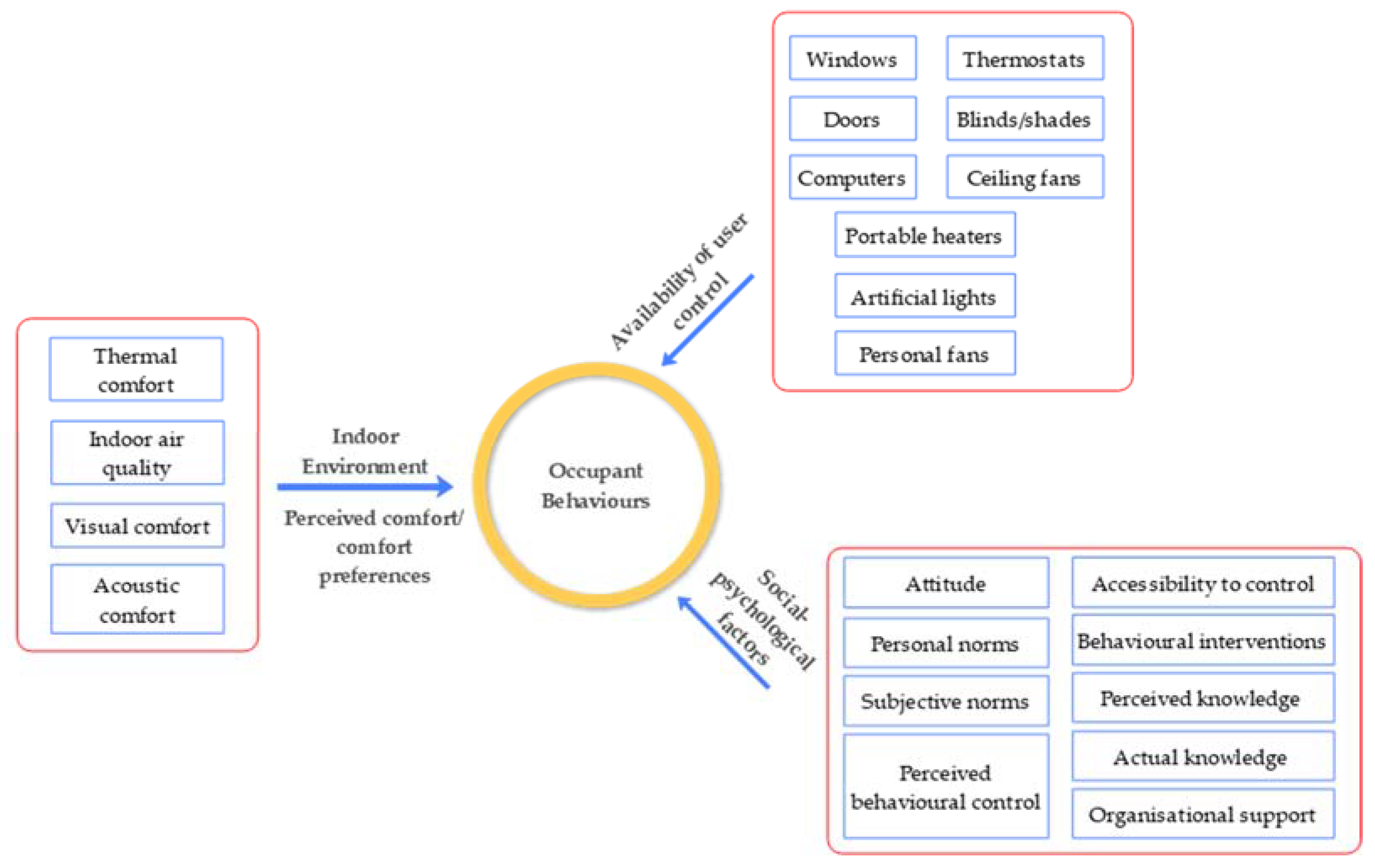
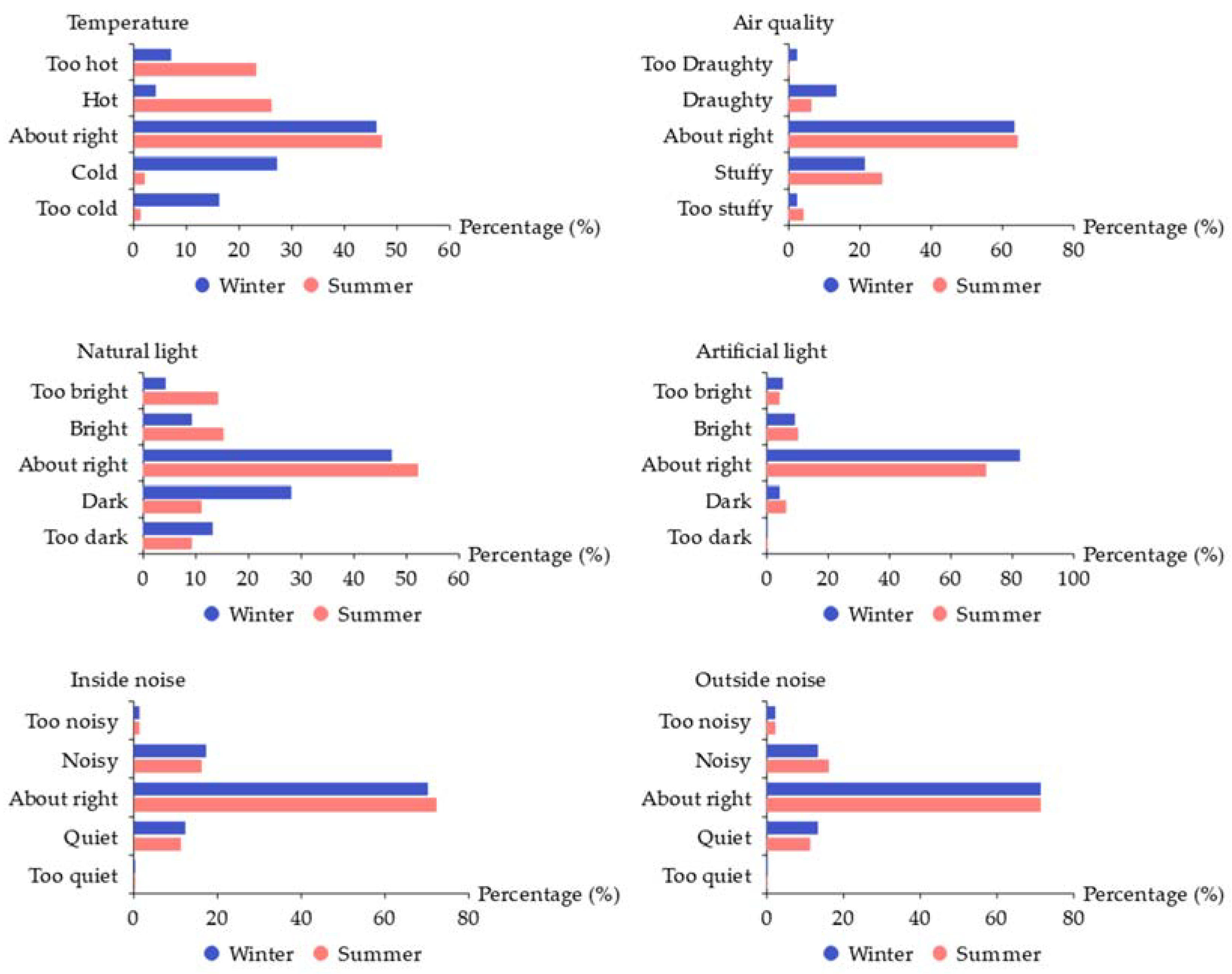
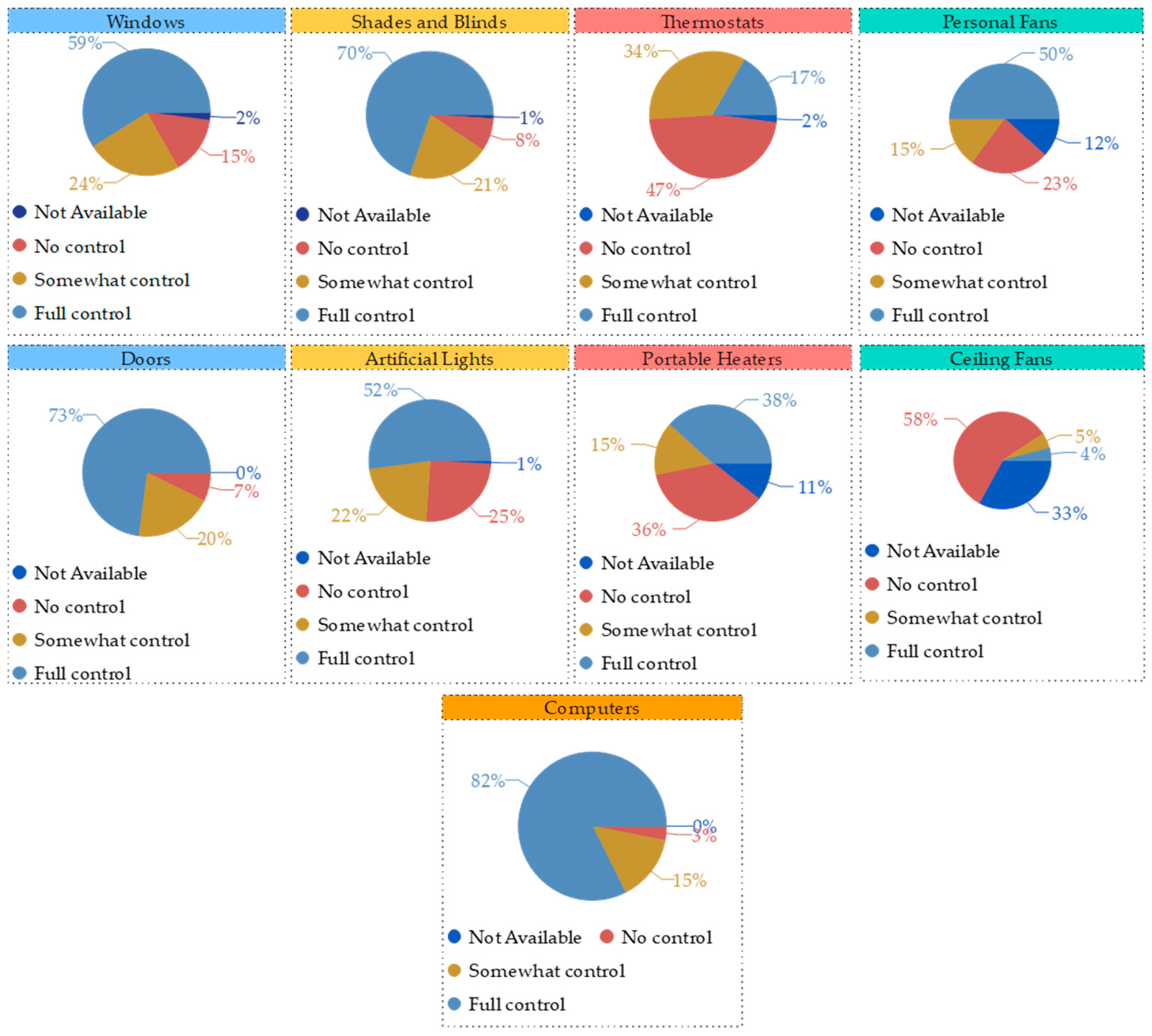


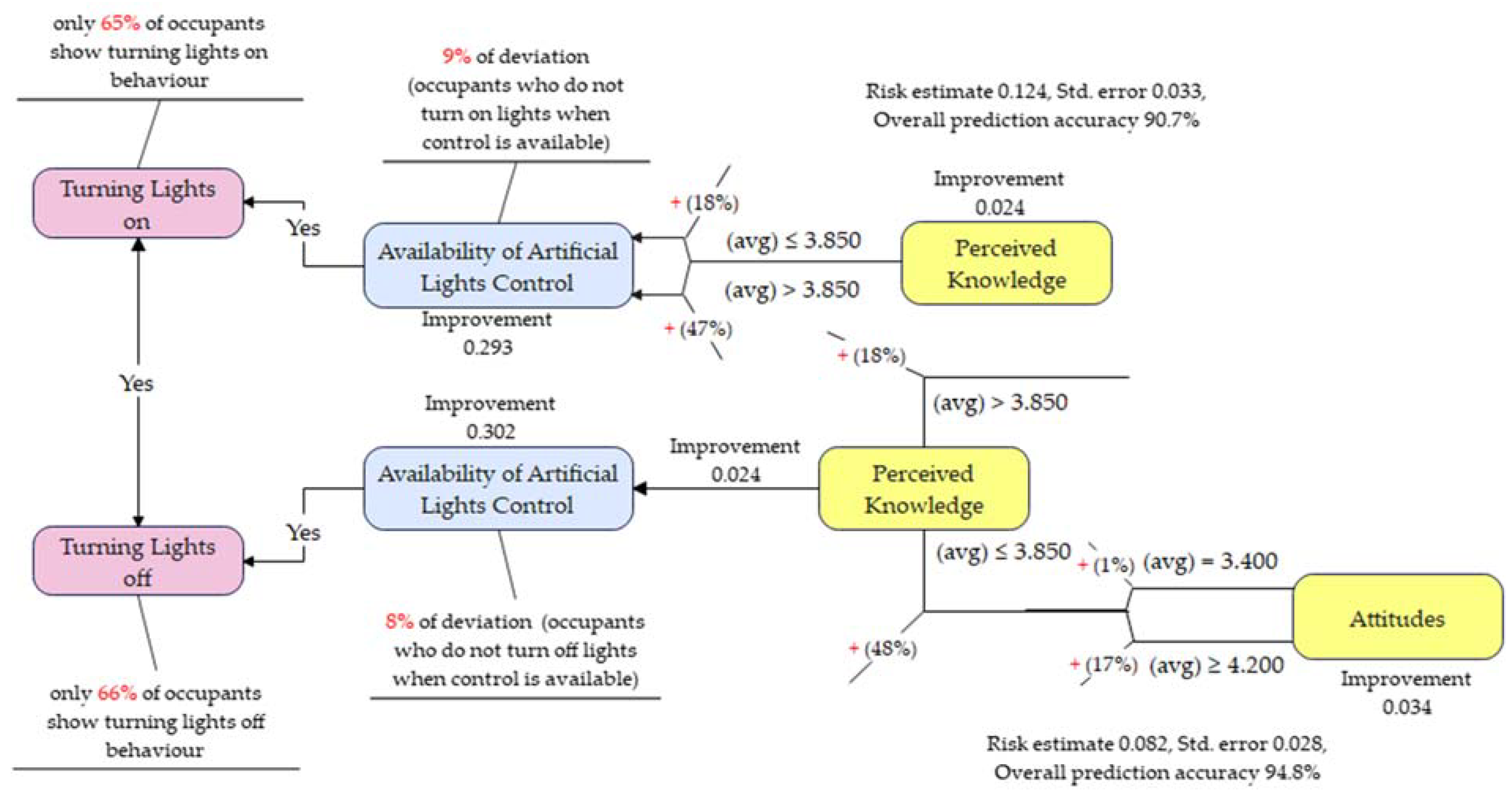
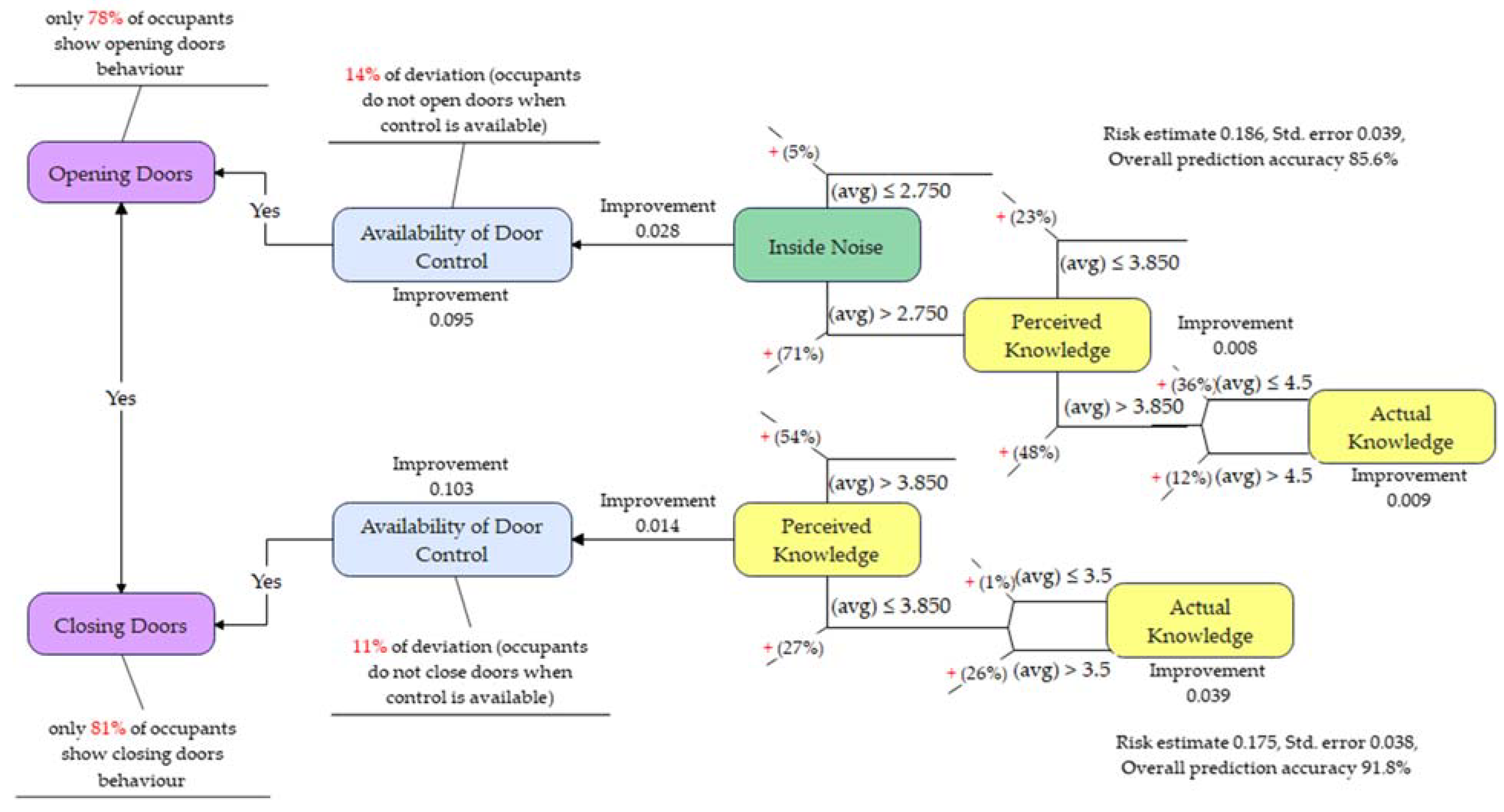
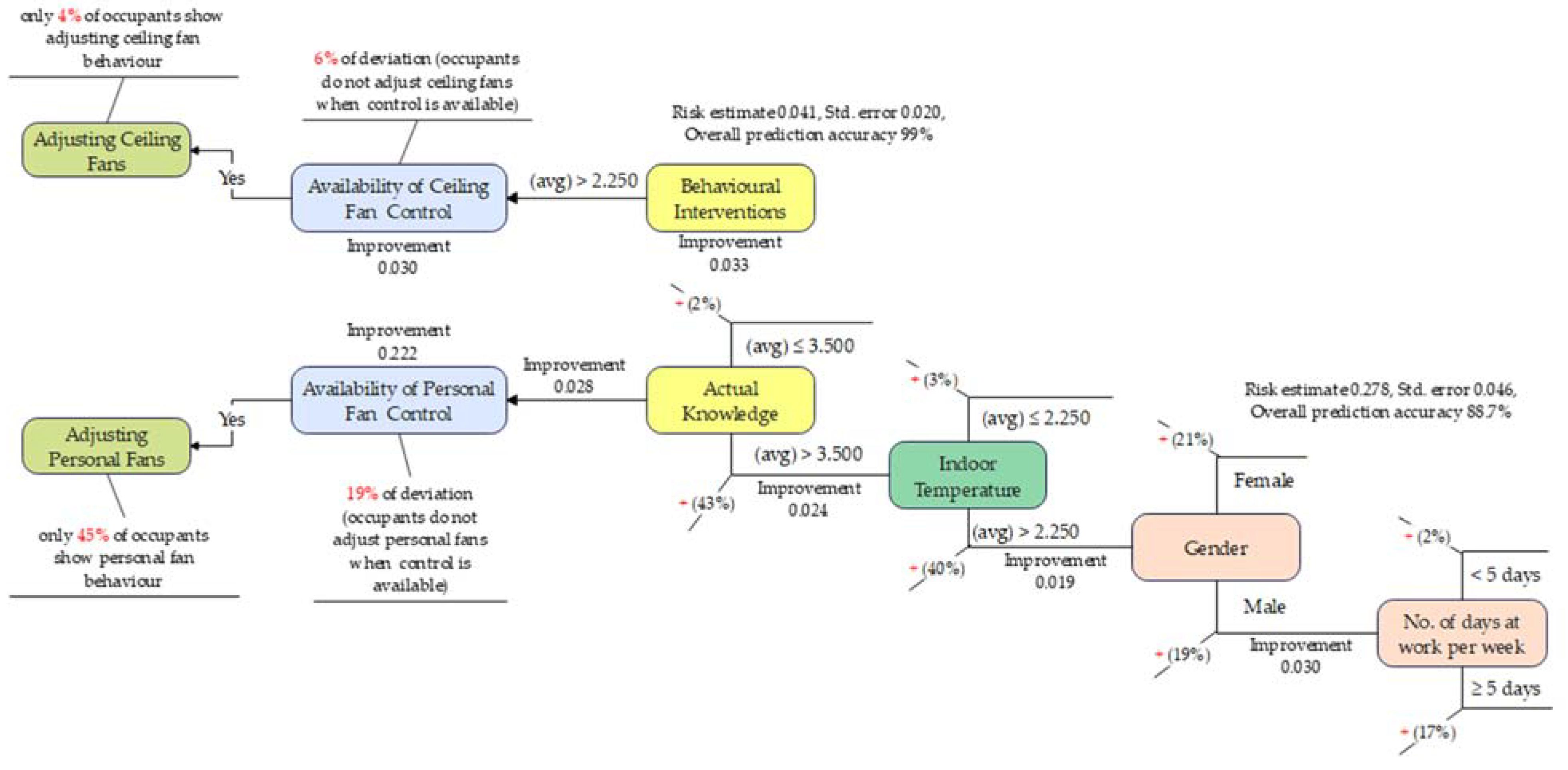

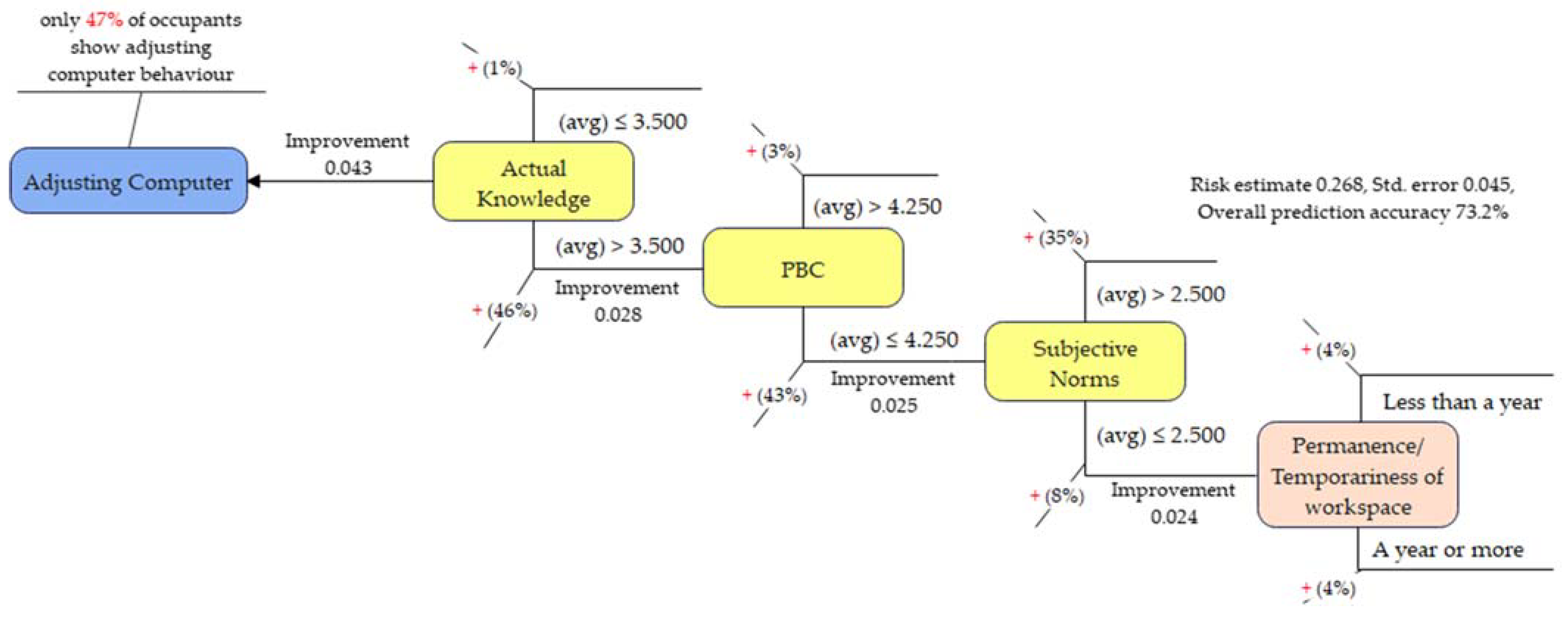
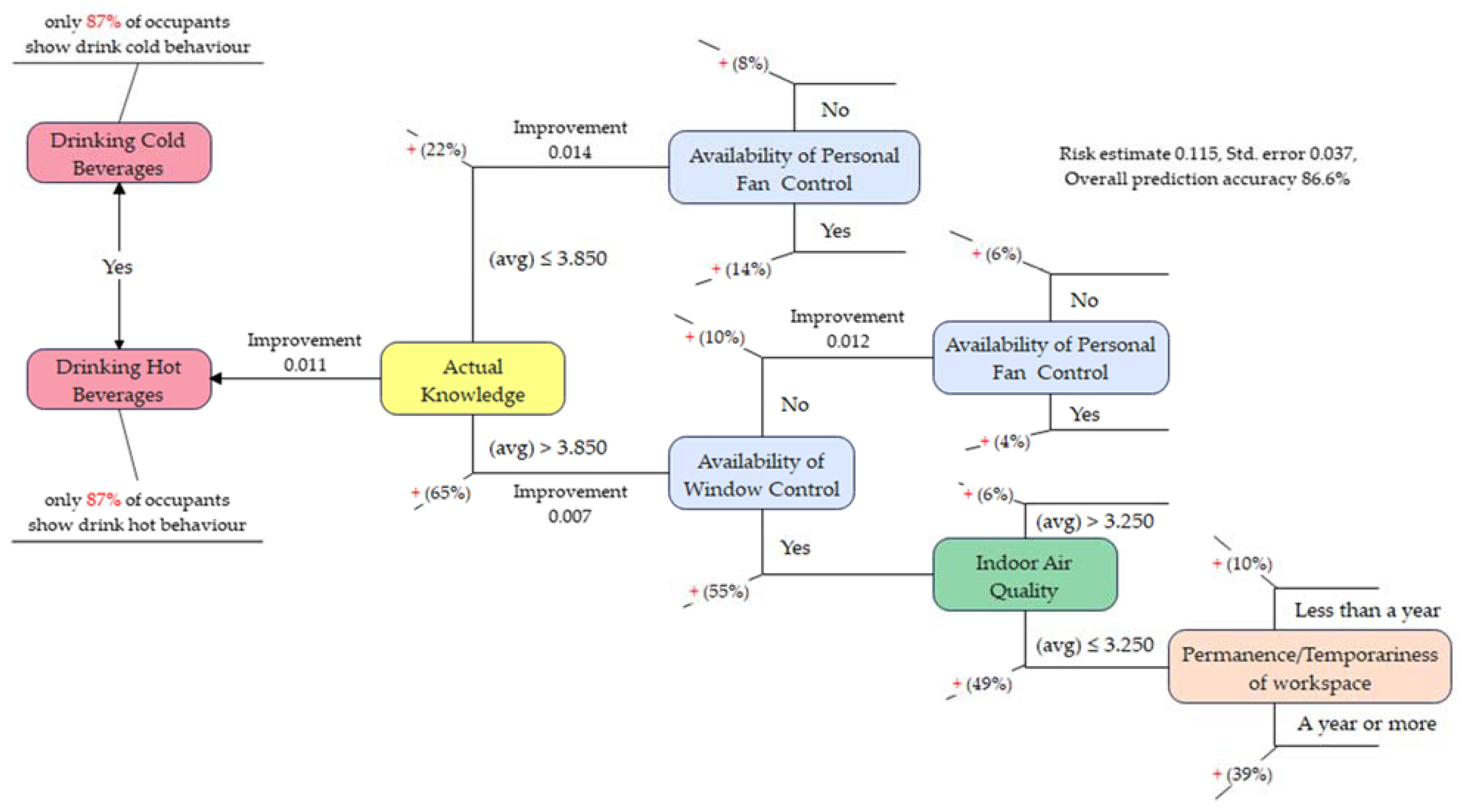
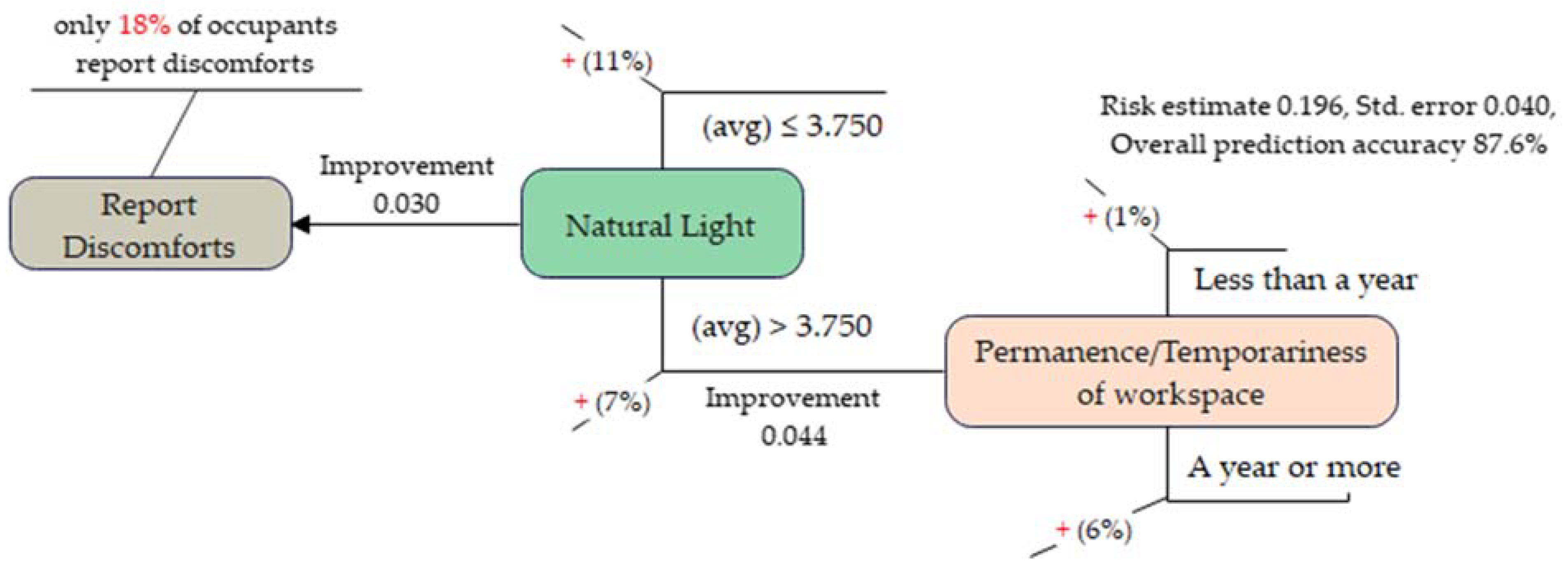

| Building Characteristics | Building A | Building B | Building C | ||||
|---|---|---|---|---|---|---|---|
| C1 | C2 | C3 | C4 | ||||
| Environmental factors | Year of completion | 1971 | 1974 | 1968 | 1968 | 1968 | 1981 |
| Life cycle (years) | 80 | ||||||
| Site/Location | Palmerston North | ||||||
| Outdoor temperature (avg.) | 9–18 °C | ||||||
| Indoor temperature | Variable | ||||||
| Wind velocity | 7 m/s | ||||||
| RH | 80% | ||||||
| Building factors | Size (UFA, GFA) | 5590 m² UFA 6285 m² GFA | 4074 m² UFA 4496 m² GFA | 3671 m² UFA 4088 m² GFA | 3631 m² UFA 4041 m² GFA | 4543 m² UFA 4982 m² GFA | 4547 m² UFA 4969 m² GFA |
| No. of floors | 8 useable floors + basement and roof plant | 5 useable floors and roof plant | 4 useable floors and roof plant | 4 useable floors and roof plant | 5 useable floors and roof plant | 5 useable floors and roof plant | |
| Storey height (m) (avg) | 3.350 m | 3.658 m | 3.658 m | 3.658 m | 3.658 m | 3.658 m | |
| Building height (m) | 27.356 m | 18.29 m | 18.59 m | 18.59 m | 22.24 m | 22.24 m | |
| Shape | Rectangular | Square | |||||
| Building orientation | NW | NE | |||||
| Glazing type | Single | ||||||
| Glazing orientation | N, S, E, W | ||||||
| Air conditioning (AC) system | Some Split AC | ||||||
| Ventilation type | Mixed mode | ||||||
| Heating system/appliances | Shared Boiler with Radiators/FCU | Shared Boiler with convectors/AHU/FCU | |||||
| Office type | Open plan, shared and single offices, and meeting rooms | Open plan, shared and single offices, meeting and consulting rooms | Single offices, meeting rooms, and teaching/research labs | ||||
| Social factors | No. of occupants (dedicated office spaces) | 321 | 198 | 137 | 172 | 174 | 256 |
| Energy feedback | Nil | ||||||
| Time factors | Equipment use schedules | Yes. Ventilation and heating | |||||
| Air changes per hour | Variable | ||||||
| Switch on times and events | 7 a.m. to 5 p.m. | 6.30 a.m. to 6 p.m. | |||||
| Demographic | Count | Percentage (%) | |
|---|---|---|---|
| Gender | Male | 52 | 53% |
| Female | 47 | 47% | |
| Ethnicity | NZ European | 69 | 70% |
| Asian | 10 | 10% | |
| Māori or Pacific | 3 | 3% | |
| Other | 17 | 17% | |
| Age | 30 or older | 92 | 93% |
| Under 30 | 7 | 7% | |
| Office Type | Single | 53 | 54% |
| Shared | 33 | 33% | |
| Open-plan | 13 | 13% | |
| Work Duration in the Building | A year or more | 76 | 77% |
| Less than a year | 22 | 22% | |
| Work Duration Present Workspace | A year or more | 66 | 67% |
| Less than a year | 32 | 32% | |
| Days of Work | 5 days or more | 51 | 52% |
| Less than 5 days | 47 | 47% | |
| Factor | Description | Mean | SD |
|---|---|---|---|
| Actual knowledge | Awareness of energy-saving benefits | 3.979 | 0.964 |
| Accessibility to control | Individual’s degree of actual controllability over building systems | 3.953 | 0.850 |
| Perceived knowledge | Use of knowledge on energy-saving | 3.942 | 0.985 |
| Attitude | Energy-saving attitudes | 3.872 | 0.901 |
| Personal norms | Responsibility/obligation to save energy | 3.563 | 0.984 |
| Perceived behavioural control (PBC) | Perceived ease/difficulty in saving energy | 3.160 | 1.168 |
| Subjective norms | Co-workers’ expectations of their peers saving energy and sharing control with co-workers | 2.678 | 1.133 |
| Organisational support | Organisation encouragement in saving energy and rewarding for savings | 1.932 | 1.121 |
| Behavioural interventions | Organisation or the building managers providing energy feedback to occupants | 1.899 | 1.255 |
Disclaimer/Publisher’s Note: The statements, opinions and data contained in all publications are solely those of the individual author(s) and contributor(s) and not of MDPI and/or the editor(s). MDPI and/or the editor(s) disclaim responsibility for any injury to people or property resulting from any ideas, methods, instructions or products referred to in the content. |
© 2023 by the authors. Licensee MDPI, Basel, Switzerland. This article is an open access article distributed under the terms and conditions of the Creative Commons Attribution (CC BY) license (https://creativecommons.org/licenses/by/4.0/).
Share and Cite
Weerasinghe, A.S.; Rasheed, E.O.; Rotimi, J.O.B. Occupants’ Decision-Making of Their Energy Behaviours in Office Environments: A Case of New Zealand. Sustainability 2023, 15, 2305. https://doi.org/10.3390/su15032305
Weerasinghe AS, Rasheed EO, Rotimi JOB. Occupants’ Decision-Making of Their Energy Behaviours in Office Environments: A Case of New Zealand. Sustainability. 2023; 15(3):2305. https://doi.org/10.3390/su15032305
Chicago/Turabian StyleWeerasinghe, Achini Shanika, Eziaku Onyeizu Rasheed, and James Olabode Bamidele Rotimi. 2023. "Occupants’ Decision-Making of Their Energy Behaviours in Office Environments: A Case of New Zealand" Sustainability 15, no. 3: 2305. https://doi.org/10.3390/su15032305
APA StyleWeerasinghe, A. S., Rasheed, E. O., & Rotimi, J. O. B. (2023). Occupants’ Decision-Making of Their Energy Behaviours in Office Environments: A Case of New Zealand. Sustainability, 15(3), 2305. https://doi.org/10.3390/su15032305








